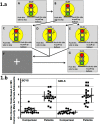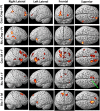Adolescents' Neural Processing of Risky Decisions: Effects of Sex and Behavioral Disinhibition
- PMID: 26176860
- PMCID: PMC4503769
- DOI: 10.1371/journal.pone.0132322
Adolescents' Neural Processing of Risky Decisions: Effects of Sex and Behavioral Disinhibition
Abstract
Background: Accidental injury and homicide, relatively common among adolescents, often follow risky behaviors; those are done more by boys and by adolescents with greater behavioral disinhibition (BD).
Hypothesis: Neural processing during adolescents' risky decision-making will differ in youths with greater BD severity, and in males vs. females, both before cautious behaviors and before risky behaviors.
Methodology/principal findings: 81 adolescents (PATIENTS with substance and conduct problems, and comparison youths (Comparisons)), assessed in a 2 x 2 design (
Patients: Comparisons x Male:Female) repeatedly decided between doing a cautious behavior that earned 1 cent, or a risky one that either won 5 or lost 10 cents. Odds of winning after risky responses gradually decreased. Functional magnetic resonance imaging captured brain activity during 4-sec deliberation periods preceding responses. Most neural activation appeared in known decision-making structures. PATIENTS, who had more severe BD scores and clinical problems than Comparisons, also had extensive neural hypoactivity. Comparisons' greater activation before cautious responses included frontal pole, medial prefrontal cortex, striatum, and other regions; and before risky responses, insula, temporal, and parietal regions. Males made more risky and fewer cautious responses than females, but before cautious responses males activated numerous regions more than females. Before risky behaviors female-greater activation was more posterior, and male-greater more anterior.
Conclusions/significance: Neural processing differences during risky-cautious decision-making may underlie group differences in adolescents' substance-related and antisocial risk-taking. Patients reported harmful real-life decisions and showed extensive neural hypoactivity during risky-or-cautious decision-making. Males made more risky responses than females; apparently biased toward risky decisions, males (compared with females) utilized many more neural resources to make and maintain cautious decisions, indicating an important risk-related brain sexual dimorphism. The results suggest new possibilities for prevention and management of excessive, dangerous adolescent risk-taking.
Conflict of interest statement
Figures





Similar articles
-
Children's brain activation during risky decision-making: A contributor to substance problems?Drug Alcohol Depend. 2017 Sep 1;178:57-65. doi: 10.1016/j.drugalcdep.2017.02.028. Epub 2017 Jun 4. Drug Alcohol Depend. 2017. PMID: 28641131 Free PMC article.
-
Risky decisions and their consequences: neural processing by boys with Antisocial Substance Disorder.PLoS One. 2010 Sep 22;5(9):e12835. doi: 10.1371/journal.pone.0012835. PLoS One. 2010. PMID: 20877644 Free PMC article.
-
Neural activation during delay discounting is associated with 6-month change in risky sexual behavior in adolescents.Ann Behav Med. 2018 Apr 19;52(5):356-366. doi: 10.1093/abm/kax028. Ann Behav Med. 2018. PMID: 29684133 Free PMC article.
-
[Risk-taking in adolescence: A neuroeconomics approach].Encephale. 2010 Apr;36(2):147-54. doi: 10.1016/j.encep.2009.06.004. Epub 2009 Sep 22. Encephale. 2010. PMID: 20434632 Review. French.
-
A meta-analytic review of the relationship between adolescent risky sexual behavior and impulsivity across gender, age, and race.Clin Psychol Rev. 2014 Nov;34(7):551-62. doi: 10.1016/j.cpr.2014.08.004. Epub 2014 Sep 16. Clin Psychol Rev. 2014. PMID: 25261740 Review.
Cited by
-
Children's brain activation during risky decision-making: A contributor to substance problems?Drug Alcohol Depend. 2017 Sep 1;178:57-65. doi: 10.1016/j.drugalcdep.2017.02.028. Epub 2017 Jun 4. Drug Alcohol Depend. 2017. PMID: 28641131 Free PMC article.
-
Brain Cortical Thickness Differences in Adolescent Females with Substance Use Disorders.PLoS One. 2016 Apr 6;11(4):e0152983. doi: 10.1371/journal.pone.0152983. eCollection 2016. PLoS One. 2016. PMID: 27049765 Free PMC article.
-
Brain circuitry associated with the development of substance use in bipolar disorder and preliminary evidence for sexual dimorphism in adolescents.J Neurosci Res. 2017 Jan 2;95(1-2):777-791. doi: 10.1002/jnr.23901. J Neurosci Res. 2017. PMID: 27870392 Free PMC article.
-
Interplay Among Self-Regulation Processes Over Time for Adolescents in the Context of Chronic Stress.J Cogn Dev. 2024;25(3):386-407. doi: 10.1080/15248372.2023.2295894. Epub 2024 Jan 29. J Cogn Dev. 2024. PMID: 39149413 Free PMC article.
-
Sex differences in animal models of decision making.J Neurosci Res. 2017 Jan 2;95(1-2):260-269. doi: 10.1002/jnr.23810. J Neurosci Res. 2017. PMID: 27870448 Free PMC article. Review.
References
-
- Centers for Disease Control and Prevention FastStats [Internet]. Leading causes of deaths among adolescents 15–19 years of age: accidents (unintentional injuries), homicide, suicide. [cited 2013 Jan 15] CDC National Center for Health Statistics, Adolescent Health, Mortality; [about 1 screen]. Available: http://www.cdc.gov/nchs/fastats/adolescent-health.htm.
-
- MacKay AP, Duran C. Adolescent Health in the United States, 2007. Hyattsville, MD: National Center for Health Statistics, U.S. Department of Health and Human Services; 2007. Publication No. 2008–1034.
Publication types
MeSH terms
Grants and funding
LinkOut - more resources
Full Text Sources
Other Literature Sources
Medical

